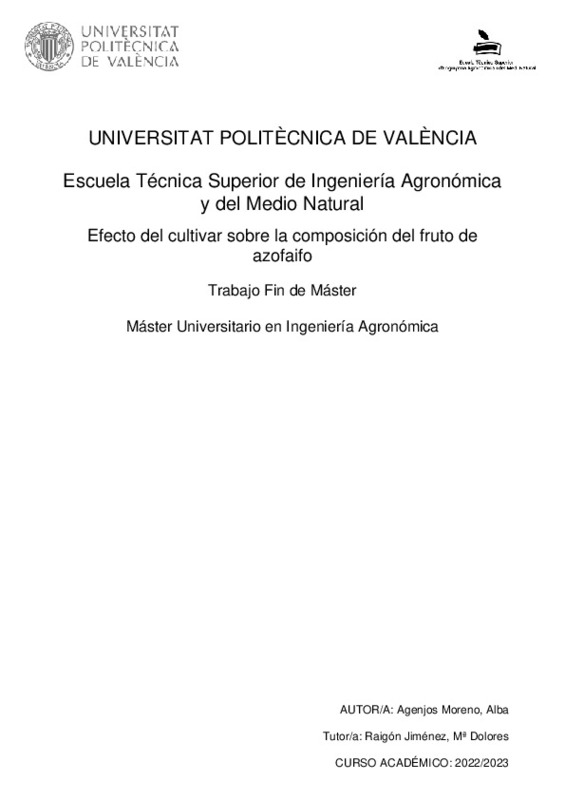|
Resumen:
|
[ES] El árbol del azofaifo o jinjolero (Ziziphus jujuba) es originario de Oriente. En el momento actual, en la Península Ibérica se trata de cultivo marginal y muy localizado o, incluso, se encuentra asilvestrado. ...[+]
[ES] El árbol del azofaifo o jinjolero (Ziziphus jujuba) es originario de Oriente. En el momento actual, en la Península Ibérica se trata de cultivo marginal y muy localizado o, incluso, se encuentra asilvestrado. Taxonómicamente pertenece a la familia Rhamnaceae. Es un árbol resistente a las bajas temperaturas y limitantes condiciones de suelo. En condiciones mediterráneas, la maduración de los frutos se produce entre finales de agosto, septiembre y principios de octubre. Se necesita elevadas cantidades de calor para fructificar.
El fruto es una drupa, de tamaño variable, puede oscilar entre los 2 cm de diámetro hasta los 5 cm de diámetro. El exocarpo lleva los colores desde verde brillante al avellana oscuro, en la madurez; la pulpa es de color blanca o blanca amarillenta, muy aromática y de sabor dulce. Poco después de madurar completamente, el fruto comienza a ablandarse y se arruga.
El principal objetivo de este trabajo es evaluar la composición de frutos de azofaifo procedentes de tres cultivares presentes en la zona de La Marjal de los Moros, Sagunto (Valencia). Dos de estos cultivares son cultivados en condiciones homogéneas en la finca de del Centro de Educación Ambiental de la Comunitat Valenciana y la tercera se trata de especies que fueron plantadas hace 20 años como seto de parcelas agrícolas de producción ecológica, y se mantiene de forma silvestre. Con ello se pretende poner en valor una fruta infravalorada y estudiar su potencial para posibles transformaciones alimentarias.
Tras el estudio realizado se llega a la conclusión de que es una fruta ligeramente ácida, con una gran cantidad de carbohidratos totales, destacando entre los azúcares solubles la fructosa y la glucosa. Los aportes de grasa son bajos y las cantidades de fibra muy interesantes. Destaca los altos contenidos de vitamina C.
[-]
[EN] The jujube tree (Ziziphus jujuba) is native to the Orient. At the present time, in the Iberian Peninsula it is a marginal and very localized crop or, even, feral. Taxonomically it belongs to the Rhamnaceae family. It ...[+]
[EN] The jujube tree (Ziziphus jujuba) is native to the Orient. At the present time, in the Iberian Peninsula it is a marginal and very localized crop or, even, feral. Taxonomically it belongs to the Rhamnaceae family. It is a tree resistant to low temperatures and limiting soil conditions. In Mediterranean conditions, the ripening of the fruits occurs between the end of August, September and the beginning of October. High amounts of heat are required to bear fruit.
The fruit is a drupe, of variable size, it can range from 2 cm in diameter to 5 cm in diameter. The exocarp takes the colors from bright green to dark hazelnut, at maturity; the pulp is white or yellowish white, very aromatic and with a sweet taste. Shortly after fully ripening, the fruit begins to soften and wrinkle.
The main objective of this work is to evaluate the composition of jujube fruits from three cultivars present in the area of La Marjal de los Moros, Sagunto (Valencia). Two of these cultivars are cultivated in homogeneous conditions on the farm of the Center for Environmental Education of the Valencian Community and the third is about species that were planted 20 years ago as a hedge of agricultural plots of organic production, and is kept in the wild. This is intended to value an undervalued fruit and study its potential for possible food transformations.
After the study carried out, it is concluded that it is a slightly acidic fruit, with a large amount of total carbohydrates, highlighting among the soluble sugars fructose and glucose. The fat contributions are low and the amounts of fiber very interesting. Highlights the high content of vitamin C.
[-]
|







